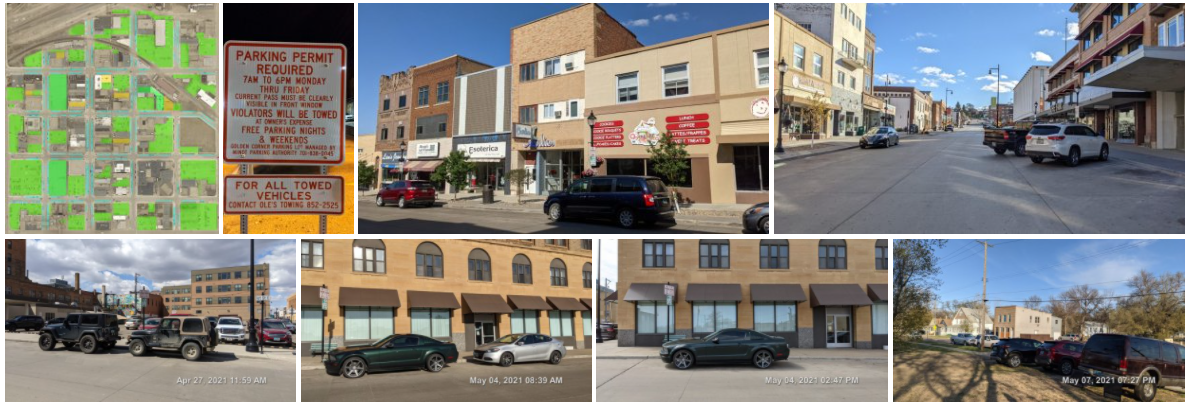Let’s start with a question: is parking ever really free? Here’s a primer on the larger challenges and the full history of our dearly held opinions on parking.
Some starting points for Downtown Minot’s parking discussion
- No parking meters in North Dakota. Did you know North Dakota is the only state that does not allow cities like Minot to put a price on street parking in our busiest places like downtown? By state law, North Dakota makes parking meters illegal.
- More than 2200 spaces! Downtown Minot between Broadway and 3rd Street and Burdick and the railroad tracks has more than 2200 off-street parking spaces. This does not include on-street parking spaces.
- Lots of ways to walk a block! If you park half-way out at Target, you walk about a one downtown block to get to front door. It makes us wonder if downtown parking is really that inconvenient, or if we just hold it to a different standard.
Here’s a Taste of the Parking Challenges We’re Seeing
But before we get to the list, let’s also share that parking is not an issue in which we will ever reach a solution. Parking is an input into a changing and evolving environment. Our goal shouldn’t be to ‘solve’ parking but to develop systems for evaluating our current situation and adapting if a need is identified. With that, here are a few items we’ve identified:
- Inconsistent laws in the wrong places. Central Avenue has 1-hour parking, nearly everywhere else has 2-hour parking. No one seems to no why. We should make our parking laws consistent in high demand areas. That said, There are parts of downtown that are not high demand. In those areas we should contemplate ordinance adjustments that allow for longer, day-use parking. This would immediately solve an enforcement challenge around Central Campus.
- Inconsistent Enforcement. This is not a criticism of police activity; circumstances are changing quickly these days and it’s difficult to keep up. Emerging circumstances show a need for increased enforcement regarding crosswalk blocking and intersection visibility. And we want to go lightly (at first) and loudly into this, letting people know it’s coming. The goals is to softly transition the public to the new standards we’re going to enforce. And this extends beyond 9:00 -5:00. Many of these challenges are emerging on nights and weekends.
- Out-of-Date Laws. Our parking laws prohibit on-street parking after 1:00 am, yet we have commerce taking place till 2:00 am. This needs to be resolved. And we have to accept that it’s going to cost money to make new signs. This is literally a cost of doing business.
- Parking Pricing Inequalities? We’ve left this is a question mark, because it’s only a possiblity that it’s a real problem. But if we have publicly subsidized parking competing against private parking and undercutting private-sector rates, that’s a problem. To be sure, it’s not a problem with an easy solution, but we need to be thinking about it just the same.
- Distribution of Parking Resources. It’s not that we don’t have enough parking, but there are instances where public parking is located far from where anyone wants to park. We need to contemplate lot repurposing lots to get daily-use public parking closer to where it’s needed.
- Merchant & Property Owner Best Practices. The responsiblity on this issue lies squarely with the DBPA. Long story short, we need to educate merchants and others that work downtown that it’s in their best interest to park far from their front door, not close.
- Infrastructure Improvements? It’s left as a question mark because we don’t know for sure, but the question has been raised on whether adding corner taping on our parallel parking spots (especially on Main Street) would guide users to more efficient use of the parking spaces.
- Aesthetic Improvements. From paving to landscaping, our parking lots are not only not interesting, in some cases they’re downright ugly. We’ve accepted our circumstance as status quo and unchangeable. It doesn’t need to be this we way. A small amount of pride matched with small investments will make a big difference!
- Minimizing Conflicts & Cooperative Agreements. From students to professional uses, to merchants and restaurants, not everyone needs parking at the same time. Partnering up may allow us to use the resource’s we have more efficiently.
- Working Together. No one has the final say on any of this, we’re all going to have to work together to get it done. That includes the City, the Parking Authority, the private sector and the public.
- Encouraging Walking, Biking, & Alternative Modes of Transportation. The easiest way to reduce parkign conflicts and parking demand is to reduce cars in downtown. It’s not complicated, but it’s rarely discussed or implmented as an actual solution. Here’s a couple related issues:
